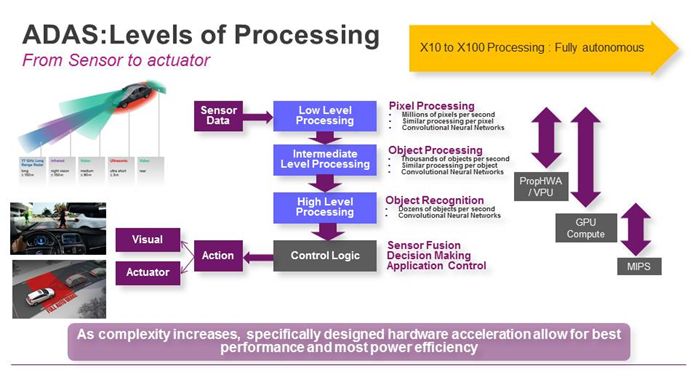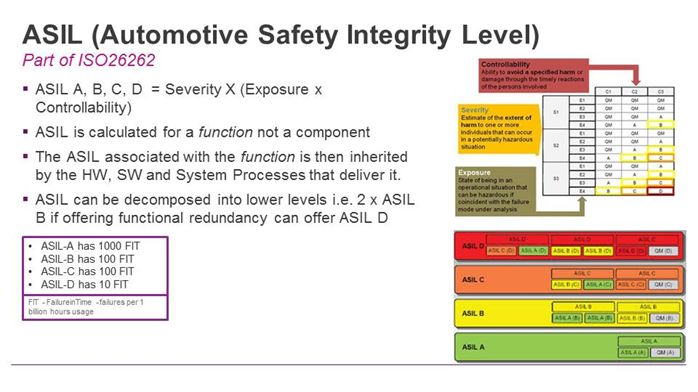Various important aspects of autonomous driving technology. “When it comes to car safety, we mainly consider two aspects. One is to reduce the dependence on the driver's technology and attention, and the other is the functional safety of the system,†said Tim Mace, senior manager of MIPS Business Development. MIPS claims to be one of the oldest industry-standard microprocessor architecture design companies in the industry. MIPS was originally founded in 1981 by Dr. John Hennessy of Stanford University. In 2012, Imagination Technologies acquired MIPS. In September of the same year, Imagination announced the sale of MIPS to the Tallwood Venture Capital Fund. “Functional safety relies on the proper operation of the system or device in response to input commands, including the necessary security management for possible operational errors, hardware failures, and environmental changes,†adds Mace. “Functional safety reflects the fault tolerance requirements of a system or equipment as a whole. The purpose of the research is to avoid direct or indirect personal injury, economic loss and environmental damage caused by these failures.†In the application of ADAS, it is necessary to cope with the increasing complexity of the system. Explosive growth of "edge processing" Driver support systems include automatic emergency braking, lane departure warning, and pedestrian detection to help reduce the number of traffic accidents directly caused by human factors. According to the National Highway Traffic Safety Administration (NHTSA), such traffic accidents account for 94% of the total number of accidents. On the other hand, the reliability, utility and integration of the system are also important. “As we move towards the era of fully automated driving, making it part of a fully integrated transportation system, the demand for 'edge' processing will increase 1,000 times over the next 10 years. Many autopilot industry insiders will say that on the system A lot of information can be stored in the cloud in the future. But in fact, this requires the system to be "open at any time, transfer at any time", and there is no bandwidth limitation, I am afraid it can be achieved in the short to medium term." Artificial intelligence (AI) is at the heart of this requirement. In a semi-automatic or fully-automobile car, the computer needs to “observe†through the on-board camera and various other sensors to understand the road conditions around the car. At present, the industry's advice for automakers is to allow cars to install up to 20 cameras. Machine learning (ML) is not only critical to sensor convergence and cloud AI needs, but also critical to overall transportation planning and early warning and diagnosis. However, Mace also warned: "After adding so many electronic functions to reduce the driver's human error, we also need to pay attention to functional safety throughout the design process of the system. This does not mean only for a certain device or system. One of the functions to test, but to ensure the overall function of the system. For example, we need to check the silicon chip part to ensure that there is no 'blocking' or transient failure." ASIL and other key standards “The ISO 26262 functional safety standard examines the failure of a device or system from multiple perspectives, including the likelihood of an accident, the severity of the accident, and the extent to which the accident can be controlled, and then the characteristics of the component. The critical values ​​are extensively tested. In the Automotive Safety Integrity Level (ASIL), Class A is the lowest level and Class D is the highest level." For example, in an OEM's safety program, all aspects related to the brake system are required to meet ASIL Class D standards. The electric window control system is almost impossible to cause serious accidents even if there is a malfunction, so only the ASIL Class A standard can be achieved in this respect. In addition, OEMs must work closely with Tier 1 or Tier 2 suppliers, processor chip vendors and IP technology providers to develop solutions to meet the requirements of the security program. Mace added: "The standard of security requirements for different parts of a device is not the same, some must reach the corresponding level of ASIL, some do not have to, and some are temporarily as long as the relatively loose ASIL level requirements are met. Yes, but the overall composition of these components must meet the corresponding ASIL level standards." At the IP level of the chip, the products offered must allow chip manufacturers and Tier 1 suppliers to ultimately achieve functional safety. "In the ISO 26262 standard system, there will be multiple chip tests per second to ensure that 'this chip is operating normally'. And what is this component device used for (such as for pedestrian detection or Lane departure warning?) is not within the scope of the test required by the standard." Mace cited the example of Mobileye's EyeQ vision processor. Speaking of the early giants in the ADAS market (now acquired by Intel), Mace mentioned: "Since EyeQ2, all models of mobileye developed and designed include MIPS microprocessors to achieve a variety of different functions. Its System-on-Chip (SoCs) technology utilizes the hardware multi-threading of the MIPS central processing unit (CPU) to improve the efficiency of the image accelerator, thereby extracting more valuable information from the sensor data of the camera." Mace said that the MIPS I6500-F model not only has the performance required for ADAS and autonomous driving, but also meets the functional safety requirements of the automotive and industrial robots, in accordance with ISO 26262 ASIL B (D) and IEC 61508. “From an industry perspective, we are fundamentally changing the electronic architecture of the car. As the car is gradually transforming into a software platform, the automotive electronics architecture is gradually moving toward the centralization of computing functions, through even the Gigabit Ethernet. Network connectivity, a large number of application programming interfaces (APIs) will be the basis for new car features and new car services." “And as the future of autonomous driving becomes clearer, the safety of critical systems is gradually gaining importance. The spread of a functional safety culture, the integration of functional safety into the entire manufacturing process, and the development of solutions for various functional safety have become Extremely important." Mace asserts that as the automotive electronics architecture evolves, the demand for computing performance increases rapidly, and the centralized and virtualized 64-bit microprocessor design becomes especially critical. Photography Accessories,Camera Flash Diffuser,Lantern Softbox Diffuser,Photography Light Diffuser SHAOXING SHANGYU FEIXIANG PHOTOGRAPHIC CO.,LTD , https://www.flying-photography.com

A description of the Class A to D standards under the ASIL system.